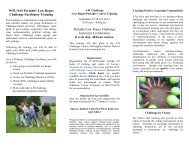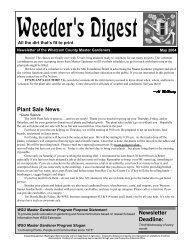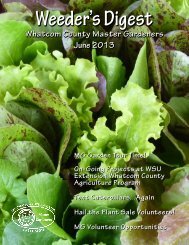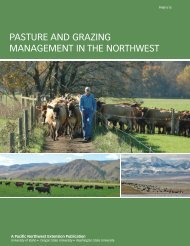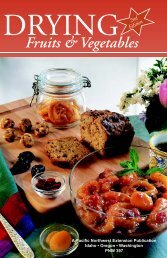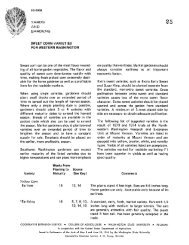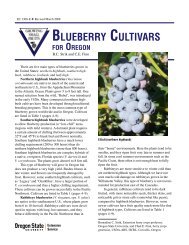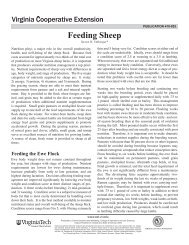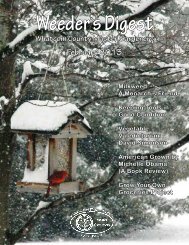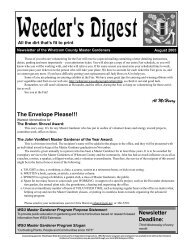Where Does Whatcom County Get its Food? - WSU Whatcom ...
Where Does Whatcom County Get its Food? - WSU Whatcom ...
Where Does Whatcom County Get its Food? - WSU Whatcom ...
Create successful ePaper yourself
Turn your PDF publications into a flip-book with our unique Google optimized e-Paper software.
various non-profit organizations providing sponsorship. The Gleaning Project coordinates volunteers to harvest<br />
leftover produce from farmers’ fields, the Bellingham Farmers Market, and home gardens for delivery to food<br />
banks and emergency meal programs throughout <strong>Whatcom</strong> <strong>County</strong>. In 2009, the amount of produce harvested<br />
was 135,129 pounds: 101,554 pounds from farm fields, 14,733 pounds from farmers market retrieval, and 18,842<br />
pounds from home gardens. Thirty-two farms participated in 2009 and 1,309.5 volunteer hours were clocked to<br />
help with gleaning and distribution. <strong>Food</strong> from the Gleaning Project went to 27 sites throughout the <strong>County</strong>.<br />
The Bellingham <strong>Food</strong> Bank <strong>Food</strong> Bank Farm<br />
This project is jointly run by Growing Washington and the Bellingham <strong>Food</strong> Bank. It started in 2007 and has<br />
expanded each year, with nearly $70,000 worth of produce donated to the <strong>Food</strong> Bank in 2009. Many volunteers,<br />
including children from school, recreational, and <strong>County</strong> programs, are integral to production of the food.<br />
Farm to <strong>Food</strong> Bank<br />
The Bellingham <strong>Food</strong> Bank runs this program, started in 2009, which contracts with local farms to grow food for<br />
<strong>Whatcom</strong> <strong>County</strong> food banks using funding from Washington State and the <strong>Whatcom</strong> Community Foundation’s<br />
Sustainable <strong>Whatcom</strong> Fund. Farmers are paid wholesale market prices for their products. Growing Washington<br />
coordinated this project locally; three identical projects ran in other areas of Washington State.<br />
Just <strong>Food</strong> CSA<br />
Growing Washington runs this project, which finds supporters to purchase CSA shares to be donated to<br />
individuals chosen by those sponsors. The CSA shares come from the Growing <strong>Whatcom</strong> CSA (a retail farm CSA<br />
program run by Growing Washington). Twenty-five shares were donated in 2008. This program is completely<br />
reliant on sponsorship from individuals and groups.<br />
Friendship Community Garden<br />
This garden is run under the umbrella of the Ferndale Service Community Cooperative. It has several community<br />
garden plots as well as a “giving garden” plot where food is produced for the Ferndale <strong>Food</strong> Bank. In 2008, 423<br />
pounds of food were delivered to the Ferndale <strong>Food</strong> Bank.<br />
Bellingham Urban Garden Syndicate (BUGS)<br />
This organization encourages urban farming and currently runs 10 gardens in Bellingham that are maintained by<br />
volunteers. Work parties are held where volunteers can work in exchange for produce. BUGS organizes an Urban<br />
Farmer Series, bringing in mainly local farmers to teach classes on food production. BUGS is also developing an<br />
urban fruit tree stewardship and harvest program.<br />
Home, Community, and School Gardens<br />
With the emergence of the trend to eat locally grown and raised food, with economic pressures of the recent<br />
months and years, and with issues of food safety in the media, more people are looking to grow their own food.<br />
For many, this means home vegetable and fruit gardens; for others, this means using community gardens where<br />
individuals or families can use a plot of land to grow food.<br />
Home <strong>Food</strong> Gardens<br />
Growing food in a home garden can range from using a few pots for growing tomatoes or herbs to using the<br />
entire yard to grow fruit and vegetables. Since home food gardens can be so varied, they are very difficult to<br />
measure.<br />
In May 2008, students from a WWU Anthropology class set up a “dot survey” at the Bellingham Farmers Market<br />
and at a book reading by Mark Winne, author of The <strong>Food</strong> Gap. On both occasions, all participants were<br />
33



